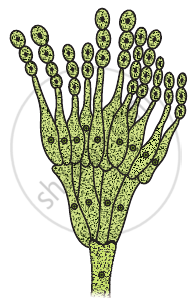Advertisements
Advertisements
Question
Draw the sketches of a zoospore and a conidium. Mention two dissimilarities between them and atleast one feature common to both structures.
Solution
 |
 |
| Zoospore | Conidiumphore |
| Dissimilarities | ||
| Zoospore | Conidium | |
| 1. | Flagellated | Non-flagellated |
| 2. | Formed inside a sporongium (endogenously) | Formed at the tip of conidiophores (exogenously) |
The common feature is that both are asexual reproductive structures.
APPEARS IN
RELATED QUESTIONS
Why do algae and fungi shift to sexual mode of reproduction just before the onset of adverse conditions?
How does the progeny formed from asexual reproduction differ from those formed by sexual reproduction?
List and describe any two vegetative propagules in flowering plants.
In the following question, there are two statements. One is the assertion (A) and the other is reasoning (R). Mark the correct answer as
- Assertion: In-bee society, all the members are diploid except drones.
- Reason: Drones are produced by parthenogenesis.
A B C D
Fleshy buds produced in the axil of leaves, which grow to form new plants when shed and fall on the ground are called ______.
Sugarcane is propagated by ______.
Amoeba and Yeast reproduce asexually by fission and budding respectively, because they are ______.
During free cell formation:
Chlamydomonas reproduce by ______.
Although sexual reproduction is a long drawn, energy-intensive complex form of reproduction, many groups of organisms in Kingdom Animalia and Plantae prefer this mode of reproduction. Give atleast three reasons for this.
